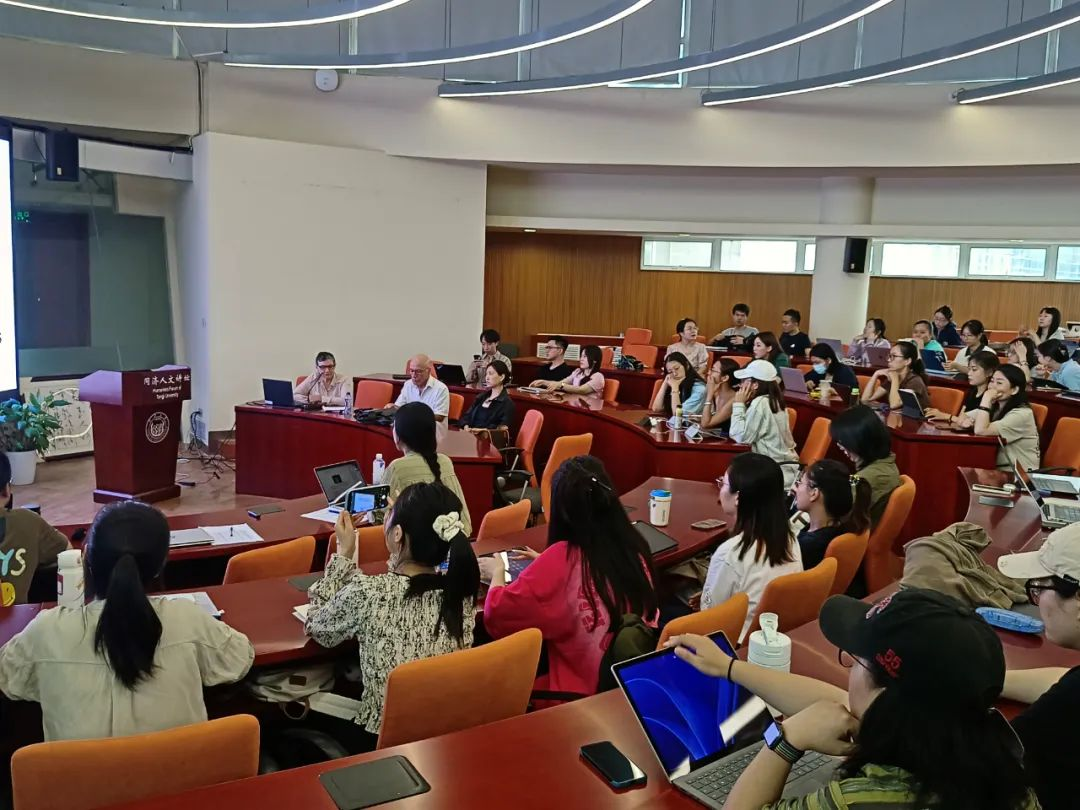On the afternoon of September 22nd, a distinguished lecture titled “From the silk industry to silky cities through a creative city: Silk in Lyon, a successful story-(telling)” was successfully held at the Yuntong Hall of the School of Humanities, Tongji University. Professor Francoise Paquienséguy, Full Professor at Sciences Po Lyon in France, researcher at Lyon research laboratory for information and communication sciences (ELICO), Vice President of the French Society of Information and Communication Sciences, member of Institut des Sciences de l’Homme in France, and research member of Excellence Laboratory IMU, delivered the lecture and shared her insights.
In her lecture, Professor Paquienséguy meticulously explored the historical trajectory of Lyon’s silk industry and the narrative strategies of innovative city development from three perspectives: “The Legacy of Silk in Lyon,” “From Art and Crafts to Industries: Lyon’s Silk Industry,” and “The City Actors’ Cooperation and Storytelling Strategies.” The rise of Lyon’s silk industry can be traced back to the 16th century when Italian silk craftsmen and merchants flocked to Lyon due to its strategic geographical location, leading to the rapid development of the local silk weaving industry. After two centuries of accumulation and expansion, Lyon emerged as a renowned silk hub, with approximately 15,000 looms and over 28,000 workers by 1788.

In the second part of her lecture, Professor Paquienséguy delved into the early industrial period of Lyon’s silk industry. In the early 19th century, there were around 8,000 silk workshop managers in Lyon. The invention of the Jacquard loom at that time greatly simplified the design and production of intricate patterned textiles, further driving the industrialization of the local silk industry. Handloom silk weavers, known as “canuts,” played a crucial role in Lyon’s silk industry and became a significant force in the widely-known workers’ movement of 1831. However, starting from the late 19th century, Lyon’s silk industry began to decline with the onset of industrialization. Initially, the main industry in the Rhône Valley, where Lyon is located, gradually shifted towards red wine production. Subsequently, the emergence of new materials, such as synthetic fibers produced through chemical processes, dealt a significant blow to the traditional silk industry. The Rhône Valley was even referred to as the “Chemical Valley” due to the dominance of chemical production.
Since the beginning of the new century, Lyon has been implementing a comprehensive new narrative strategy for the city, gradually reviving its image as the “City of Silk.” The focal point of this lecture lies in Lyon’s narrative approach to shaping its innovative city image and the diverse opinions from various stakeholders involved in this transformation, which have been discussed in the third segment of the lecture. Professor Paquienséguy emphasized the design and implementation details of the narrative strategy of Lyon, highlighting its significant implications in crafting the city’s story. Rooted in concepts like “Regimes of Action,” this strategy focuses on Lyon’s prosperous silk industry history from innovative, market, and urban perspectives. It orchestrates collaboration between the municipal government and various economic participants, aiming to establish a comprehensive plan of city enrichment. This plan comprises three key elements: firstly, engaging all stakeholders in the city’s development; secondly, narrating the historical silk story of the city; thirdly, exploring the close connections between cultural industries, heritage conservation, commercial activities, and communication strategies, with initiatives such as establishing the Silk Workshop Heritage Museum and the Fabric Museum as part of this effort. With these concerted efforts, Lyon has transitioned from a city dominated by chemical industries to an innovative city.
Lyon’s efforts to “tell the silk story” is closely related to China and its “Silk Road.” The Lyon city government has continuously been exploring historical and cultural links with China and the Silk Road, including but not limited to activities commemorating the 50th anniversary of Sino-French diplomatic relations in 2014, reviewing the history of the Lyon French-Chinese Institute (L’Institut France-Chinois de Lyon) between 1921 and 1946, opening a new Silk Road cargo route by train between Wuhan and Lyon in 2016, and closely collaborating with Chinese partners during the 2018 Silk Lyon Festival.
In the concluding part of the lecture, Professor Paquienséguy engaged in an in-depth discussion with the attending students and faculty, comprehensively addressing questions about the silk industry, Lyon's city branding, French-Chinese silk cultural relationships, and their comparative analyses.
